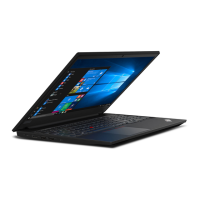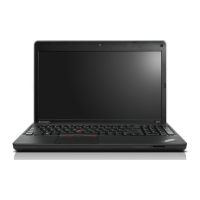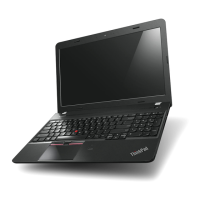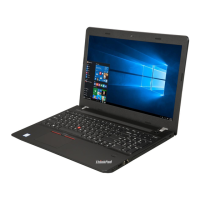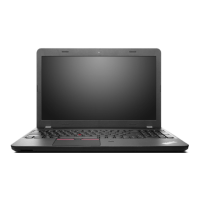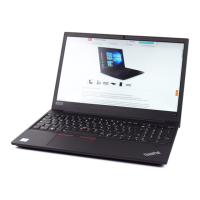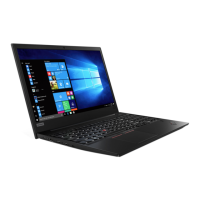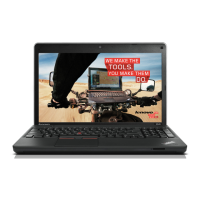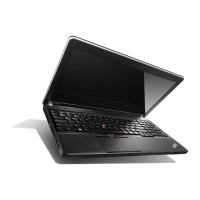Do you have a question about the Lenovo ThinkPad E590 and is the answer not in the manual?
Details the front components like microphones and camera.
Explains the base components including power button, keypad, and trackpad.
Lists and describes ports on the left side: USB-C, HDMI, Always On USB.
Lists and describes ports on the right side: microSD, USB 2.0, Ethernet, security lock.
Overviews the computer's features like processor, memory, and keyboard.
Provides detailed technical specifications such as size and power.
Introduces Windows 10 basics for new users.
Explains the requirement and types of user accounts in Windows.
Explains the components of the Windows user interface.
Guidance on connecting to wired and wireless networks.
Overview of Lenovo Vantage for system management and support.
Explains special keys and shortcuts for efficient operation.
Explains how to use the trackpad for navigation and control.
Steps to connect and use external displays.
Information on managing power for optimal performance and efficiency.
How to select and customize power plans.
Steps to establish a Bluetooth connection with devices.
Instructions for using the microSD card slot.
How to secure the computer using a cable lock.
Introduces UEFI BIOS password types and management.
How to use fingerprint scanning for login.
Guidance on using firewall and antivirus software for security.
Introduction to UEFI BIOS and its configuration.
Steps to update the UEFI BIOS.
Overview of system recovery options.
Guide to creating and using a recovery USB drive.
Guide to installing the operating system and drivers.
Defines Customer Replaceable Units (CRUs).
Procedure for replacing the base cover assembly.
Steps to replace the computer's memory module.
Procedure for replacing the speaker assembly.
Instructions for replacing the hard disk drive.
Steps to replace the M.2 solid-state drive.
Instructions for replacing the computer keyboard.
Procedure for replacing the fingerprint reader.
Frequently asked questions and their solutions.
Lists common error messages and troubleshooting steps.
Various resources for troubleshooting and support.
Information on contacting Lenovo support for assistance.
General safety guidelines and warnings for computer use.
Tips for optimal computer usage and user comfort.
Precautions against heat from the computer and adapter.
Safety precautions for using power cords and adapters.
Safety information regarding electrical plugs and outlets.
Important safety information regarding batteries.
Guidelines on managing computer heat and ventilation.
Safety measures for handling electrical currents and cables.
How to prevent static electricity damage to components.
Tips for cleaning and maintaining the computer.
Statements regarding RF compliance for wireless devices.
Information on RF safety and environmental usage.
Environmental, recycling, and RoHS info by region.
Guidelines for recycling Lenovo computers in Japan.
Information on ENERGY STAR compliance for Lenovo products.
General notices regarding Lenovo products and documentation.
Lists trademarks associated with Lenovo and its products.
Details the front components like microphones and camera.
Explains the base components including power button, keypad, and trackpad.
Lists and describes ports on the left side: USB-C, HDMI, Always On USB.
Lists and describes ports on the right side: microSD, USB 2.0, Ethernet, security lock.
Overviews the computer's features like processor, memory, and keyboard.
Provides detailed technical specifications such as size and power.
Introduces Windows 10 basics for new users.
Explains the requirement and types of user accounts in Windows.
Explains the components of the Windows user interface.
Guidance on connecting to wired and wireless networks.
Overview of Lenovo Vantage for system management and support.
Explains special keys and shortcuts for efficient operation.
Explains how to use the trackpad for navigation and control.
Steps to connect and use external displays.
Information on managing power for optimal performance and efficiency.
How to select and customize power plans.
Steps to establish a Bluetooth connection with devices.
Instructions for using the microSD card slot.
How to secure the computer using a cable lock.
Introduces UEFI BIOS password types and management.
How to use fingerprint scanning for login.
Guidance on using firewall and antivirus software for security.
Introduction to UEFI BIOS and its configuration.
Steps to update the UEFI BIOS.
Overview of system recovery options.
Guide to creating and using a recovery USB drive.
Guide to installing the operating system and drivers.
Defines Customer Replaceable Units (CRUs).
Procedure for replacing the base cover assembly.
Steps to replace the computer's memory module.
Procedure for replacing the speaker assembly.
Instructions for replacing the hard disk drive.
Steps to replace the M.2 solid-state drive.
Instructions for replacing the computer keyboard.
Procedure for replacing the fingerprint reader.
Frequently asked questions and their solutions.
Lists common error messages and troubleshooting steps.
Various resources for troubleshooting and support.
Information on contacting Lenovo support for assistance.
General safety guidelines and warnings for computer use.
Tips for optimal computer usage and user comfort.
Precautions against heat from the computer and adapter.
Safety precautions for using power cords and adapters.
Safety information regarding electrical plugs and outlets.
Important safety information regarding batteries.
Guidelines on managing computer heat and ventilation.
Safety measures for handling electrical currents and cables.
How to prevent static electricity damage to components.
Tips for cleaning and maintaining the computer.
Statements regarding RF compliance for wireless devices.
Information on RF safety and environmental usage.
Environmental, recycling, and RoHS info by region.
Guidelines for recycling Lenovo computers in Japan.
Information on ENERGY STAR compliance for Lenovo products.
General notices regarding Lenovo products and documentation.
Lists trademarks associated with Lenovo and its products.
| Form factor | Clamshell |
|---|---|
| Product type | Laptop |
| Product color | Black |
| Housing material | Acrylonitrile butadiene styrene (ABS), Aluminium, Polycarbonate (PC) |
| Market positioning | Business |
| Panel type | TN |
| LED backlight | Yes |
| Display surface | Matt |
| Display diagonal | 15.6 \ |
| Display brightness | 220 cd/m² |
| Display resolution | 1366 x 768 pixels |
| Native aspect ratio | 16:9 |
| Contrast ratio (typical) | 400:1 |
| Pointing device | ThinkPad UltraNav |
| Keyboard language | Spanish |
| Bus type | OPI |
| Tjunction | 100 °C |
| Processor cache | 6 MB |
| Processor cores | 4 |
| System bus rate | 4 GT/s |
| Processor family | Intel® Core™ i5 |
| Processor socket | BGA 1528 |
| Processor threads | 8 |
| Processor codename | Whiskey Lake |
| Configurable TDP-up | 25 W |
| Processor frequency | 1.6 GHz |
| Processor cache type | Smart Cache |
| Configurable TDP-down | 10 W |
| Processor lithography | 14 nm |
| Processor manufacturer | Intel |
| PCI Express slots version | 3.0 |
| Processor boost frequency | 3.9 GHz |
| Processor operating modes | 64-bit |
| PCI Express configurations | 1x4, 2x2 |
| Thermal Design Power (TDP) | 15 W |
| Configurable TDP-up frequency | 1.8 GHz |
| Configurable TDP-down frequency | 0.8 GHz |
| Maximum number of PCI Express lanes | 16 |
| Memory slots | 2x SO-DIMM |
| Internal memory | 16 GB |
| Memory clock speed | 2400 MHz |
| Memory form factor | SO-DIMM |
| Internal memory type | DDR4-SDRAM |
| Maximum internal memory | 32 GB |
| SSD capacity | The Solid State Drive's storage capacity in Gigabytes. |
| SSD interface | NVMe, PCI Express |
| Storage media | SSD |
| Total storage capacity | 256 GB |
| Compatible memory cards | MicroSD (TransFlash) |
| Number of SSDs installed | 1 |
| On-board graphics card ID | 0x3EA0 |
| Discrete graphics card model | Not available |
| On-board graphics card family | Intel® UHD Graphics |
| On-board graphics card OpenGL version | 4.5 |
| On-board graphics card base frequency | 300 MHz |
| On-board graphics card DirectX version | 12.0 |
| On-board graphics card dynamic frequency (max) | 1100 MHz |
| Battery capacity | 45 Wh |
| Battery life (max) | 11 h |
| Number of battery cells | 3 |
| AC adapter power | 65 W |
| Audio chip | Synaptic CX11880 |
| Audio system | Dolby Advanced Audio |
| Speaker power | 2 W |
| Number of built-in speakers | 2 |
| Front camera resolution | 1280 x 720 pixels |
| Cable lock slot type | Kensington |
| Password protection type | HDD, Power on, Supervisor |
| Antenna type | 2x2 |
| Wi-Fi standards | 802.11a, 802.11b, 802.11g, Wi-Fi 4 (802.11n), Wi-Fi 5 (802.11ac) |
| Top Wi-Fi standard | Wi-Fi 5 (802.11ac) |
| Ethernet LAN data rates | 10, 100, 1000 Mbit/s |
| Sustainability certificates | RoHS, EPEAT Silver, ENERGY STAR |
| HDMI version | 1.4b |
| Charging port type | USB Type-C |
| USB 2.0 ports quantity | USB 2.0 ports have a data transmission speed of 480 Mbps, and are backwards compatible with USB 1.1 ports. You can connect all kinds of peripheral devices to them. |
| USB 3.2 Gen 1 (3.1 Gen 1) Type-C ports quantity | 0 |
| Processor ARK ID | 149088 |
| Processor package size | 46x24 mm |
| Supported instruction sets | AVX 2.0, SSE4.1, SSE4.2 |
| Intel Identity Protection Technology version | 1.00 |
| Intel Stable Image Platform Program (SIPP) version | 0.00 |
| Depth | 252.5 mm |
|---|---|
| Width | 369 mm |
| Height | 19.9 mm |
| Weight | 2120 g |
